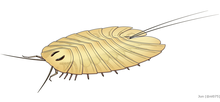셀로니엘리다
Cheloniellida| 셀로니엘리다 시간 범위: | |
|---|---|
 | |
| 첼로니엘론 복원 | |
| 과학적 분류 | |
| 왕국: | 애니멀리아 |
| 문: | 절지동물 |
| (순위 미지정): | †장족류 |
| (순위 미지정): | †비시시카우다타 |
| (순위 미지정): | †셀로니엘리다 브로일리, 1932년 |
| 속 | |
첼로니엘리다(Cheloniellida)는 멸종한 고생대 절지동물의 분류군이다[1][2].2018년 [2]현재, 7개의 셀로니엘류 단형 속들이 공식적으로 기술되었으며, 이들의 화석은 오르도비스기부터 데본기에 이르는 해양 지층에서 발견된다.Cheloniellida는 다양한 화석과 현존하는 절지동물 [2]분류군의 일원 또는 친척으로 관련지어지면서 논란이 많은 계통발생학적 위치를 가지고 있다.그것은 나중에 아르티오포다 [3][4][5]내에서 Vicissicaudata의 일원으로 받아들여졌다.
형태학

셀로니엘리드의 납작한 난형체는 눈을 가진 두부(머리)와 일련의 터가이트(도골 외골격)에 의해 등쪽으로 분할된 분할된 트렁크 영역으로 구성됩니다.두부는 프로케팔론과 그나토케팔론으로 [2]나눌 수 있다.다른 아티오파다에 비해 셀로니엘리드의 두부 실드(두골격의 두부 [2][3]외골격)가 상대적으로 감소한다.줄기는 머리보다 넓고 8-13개의 터가이트로 이루어져 [2]있다.처음 몇 개의 터가이트의 흉막(측방) 팁은 전방으로 향하며, 점점 후방으로 향하게 되어 터가이트 사이의 세그먼트 경계는 방사상으로 나타난다.[3][2]포스트아브도멘이라고도 [4]알려진 마지막 몸통 부분은 작고, 이전 터가이트의 [2]흉막 영역으로 측면으로 둘러싸여 있습니다.
이용 가능한 재료에 기초하여 두부는 한 쌍의 더듬이와 5쌍의 유니라무스 부속물로 구성되며, 뒷부분 4쌍은 아가토베이스를 [6]가진다.비염기성 두부 부속물이 일부 [6][2]종에서 특화되거나 심지어 맹금류라는 증거가 있다.각 줄기 세그먼트(마지막 세그먼트 제외)는 다리 모양의 내족동물과 짧은 [2]외족동물로 이루어진 한 쌍의 편평성 부속물을 가진다.마지막 줄기 세그먼트에는 furcae[3] 또는 [6]cerci라고 불리는 한 쌍의 척추/허리 모양의 부속물이 있으며, 일부 종은 그 사이에 [2]텔슨일 수도 있고 아닐 수도 있는 내측 척추를 가지고 있다.
분류
계통발생적 위치
Boudreaux(1979)는 Cheloniellida를 하나의 [8]과로 간주했지만, 후속 연구는 Cheloniellida를 보통 하나의 [1][2]과로 취급한다.첼로니엘리다는 절지동물 상위 분류에서 논란이 되는 계통발생학적 위치를 가지고 있으며, 주로 20세기 경에 연구 결과 갑각류, 트릴로비타, 첼리세라타 또는 아글라스피디다 [2]중 하나의 친척/구성원으로 추정되고 있다.어떤 종들은 심지어 처음 [9]묘사되었을 때 폴리플라코포라 연체동물로 잘못 식별되었다.원래, 상징적인 첼로니엘리드 첼로니엘론은 삼엽충과 비슷한 갑각류로 [10][11]여겨졌습니다.후속 저자들은 삼엽충과 [6][7]섬모충 사이의 중간 위치를 차지했으며, 일부 저자들은 또한[12] 갑각류나[13][14] 섬모충의 자매 집단으로 해석하기도 했다.셀로니엘류(cheloniellids)와 셀리케이트(chelicate) 사이의 밀접한 관계는 메로스톰(Xiposurans)과 에우리프테리드(Eurypterides)와 유사한 gnathobasic 부속물, 그리고 셀리케이트가 독일 대뇌 더듬이의 상실을 통해 발생했다는 가설에 의해 추론되었다.유전자의 발현,[15][16][17][18][19] 신경해부학적[20][21] 및 발달적[22] 증거(실제로 뇌신경계라는 증거)에 의해 뒷받침되지 않는 시나리오(celicerae)[6][7]인 chelicerae(chelicerae)에 부속된다.
| ||||||||||||||||||||||||||||||||||||||||||||||||||||||||||||||||||||||||||||||||||||||||||
| Lerosey-Aubril et al.(2017)[4]에 기초한 Cheloniellida에 초점을 맞춘 Artiopoda의 계통발생 요약. |
21세기에 첼로니엘리다는 아글라스피디다와 크세노포다(시드니아,[23][3][24][25][4] 에메랄델라 등)와 함께 대부분 분지군을 형성하는 것으로 밝혀졌다.이 [3]분지군은 2013년에 공식적으로 Vicissicaudata로 명명되었으며, 다리와 같지 않은 [3][4]한 쌍의 부속물이 있는 차별화된 말단 몸통 영역(포스트탭도멘)에 의해 통합되었다.또한 수많은 계통발생학적 분석에서 아티오포다 내의 Vicissicaudata를 찾아냈다.아티오포다 [4]내에서는 3엽충과 유사한 화석 분류군으로 구성되며[26][24], 셀리세이트와 밀접한 관련이 있을 수도 있고 그렇지 않을 수도[3][25][4] 있다.
포함속 및 종
셀로니엘리드의 명확한 멤버는 다음과 같습니다.
- 첼로니엘론 브로일리, 1932년
- 첼로니엘론 칼마니 브로일리, 1932년 - 로더 데본, 독일
- 두슬리아 얀, 1893년
- Duslia 휘장 Jahn, 1893 - 상부 오르도비스기, 체코, 모로코
- 에두슬리아 비달, 1998
- Eoduslia brahimtahiri Vidal, 1998 - 상부 오르도비치안, 모로코
- 네오스트라밥스 캐스터 & 맥키, 1952년
- Neostrabps martini Caster & Macke, 1952 - Upper Ordovician, 미국
- 파라다일리아 Dunlop, 2002
- Paraduslia talimaae Dunlop, 2002 - 러시아 데본기 하부
- 유사 가트론 셀던 & 화이트, 1984년
- Pseudarthron Whitingtoni Selden & White, 1984 - Upper Siluarian
- 트리오푸스속 바랑드, 1872
- Triopus drabowiensis Barande, 1872년 - 모로코, 체코, 오르도비스기 상부
2018년, 새로운 종(2016년부터[27] 발표되지 않은 논문에서 비공식적으로 "라트로바이러스"로 명명됨)이 Wendruff [28]등에 의해 프리프린트에 기술되었다.Braddy & Dunlop 2021에 따르면 수수께끼의 파리오스코르피오는 첼로니엘리드 [29]친화력을 가질 수 있지만, 그러한 해석은 Van Roy 외 연구진 2022에 의해 부정되며, 가능한 첼로니엘리드 [30]표본으로 남은 표본 UWGM 2349(Latromirus의 홀로타입 표본)만 남아 있다.
레퍼런스
- ^ a b Hou, Xianguang. (1997). Arthropods of the Lower Cambrian Chengjiang fauna, southwest China (PDF). Bergström, Jan, 1938-. Oslo: Scandinavian University Press. ISBN 82-00-37693-1. OCLC 38305908.
- ^ a b c d e f g h i j k l m 웬드러프, 앤드류 제임스 등"미국 위스콘신주 실루리아 산맥에서 온 커다란 랩토리얼 부속물을 가진 새로운 첼로니엘리드 절지동물." BioRxiv(2018) : 407379.[1]
- ^ a b c d e f g h Ortega-Hernández, Javier; Legg, David A.; Braddy, Simon J. (February 2013). "The phylogeny of aglaspidid arthropods and the internal relationships within Artiopoda". Cladistics. 29 (1): 15–45. doi:10.1111/j.1096-0031.2012.00413.x. S2CID 85744103.
- ^ a b c d e f g Lerosey-Aubril, Rudy; Zhu, Xuejian; Ortega-Hernández, Javier (2017-09-11). "The Vicissicaudata revisited – insights from a new aglaspidid arthropod with caudal appendages from the Furongian of China". Scientific Reports. 7 (1): 11117. doi:10.1038/s41598-017-11610-5. ISSN 2045-2322. PMC 5593897. PMID 28894246.
- ^ Du, Kun-sheng; Ortega-Hernández, Javier; Yang, Jie; Zhang, Xi-guang (2019). "A soft-bodied euarthropod from the early Cambrian Xiaoshiba Lagerstätte of China supports a new clade of basal artiopodans with dorsal ecdysial sutures". Cladistics. 35 (3): 269–281. doi:10.1111/cla.12344. ISSN 0748-3007. S2CID 89985331.
- ^ a b c d e f Stürmer, Wilhelm; Bergström, Jan (1978). "The arthropod Cheloniellon from the devonian hunsrück shale". Paläontologische Zeitschrift. 52 (1): 57–81. doi:10.1007/BF03006730. S2CID 87725308.
- ^ a b c STfJRMER, W. t~ BERGSTROM, J. 1981.웨인버그나, 데본기 훈스리크 슬레이트의 시포수란 절지동물.- Palaontologische Zeitschrift 55: 237-255.[2]
- ^ 부드로 H. B., 1979년절지동물 계통 발생 및 절지동물 단통 분류에서 절지동물 간 힘줄 시스템의 중요성. 페이지 551-586.입력: Gupta A.P. [Ed.]절지동물 계통 발생밴 노스트랜드 라인홀드 컴퍼니, 뉴욕, 1-762
- ^ 취루팍 1세체코슬로바키아의 오르도비스기에 사는 불가사의한 절지동물 둘리아.팔래온톨1988; 31:611–620.[3]
- ^ 브로일리, F. (1932) :아인노이어 크러스타시 아우스 뎀 라이니스첸 운터데본.-시츠베르.바이엘 아카드입니다미스: 27-38. 민천.[4]
- ^ 브로일리, F. (1933) :아인 즈웨이트의 예시 폰 첼로니엘론.--시츠버그.바이엘 아카드입니다미스: 11-32; 민천.[5]
- ^ Delle Cave, L. and A.M. Simonetta(1991) 초기 고생대 절지동물과 절지동물 계통발생 문제; 의심스러운 친화성의 분류에 대한 몇 가지 주석.메타조아의 초기 진화와 문제 있는 분류의 의의, eds.A.M. 시모네타와 S.콘웨이 모리스입니다캠브리지 대학 출판부, 영국 캠브리지권 189~244
- ^ Wills, M. A., Briggs, D. E. G., Fortey, R. A. & Wilkinson, M. 1995.절지동물의 진화를 이해하는 데 있어서 화석이 갖는 중요성.Verhandlungen der deutschen Zoologischen Geselschaft 88, 203–15.
- ^ Dunlop, J. A.; Selden, P. A. (1998), Fortey, R. A.; Thomas, R. H. (eds.), "The early history and phylogeny of the chelicerates", Arthropod Relationships, The Systematics Association Special Volume Series, Dordrecht: Springer Netherlands, pp. 221–235, doi:10.1007/978-94-011-4904-4_17, ISBN 978-94-011-4904-4
- ^ Telford, Maximilian J.; Thomas, Richard H. (1998-09-01). "Expression of homeobox genes shows chelicerate arthropods retain their deutocerebral segment". Proceedings of the National Academy of Sciences. 95 (18): 10671–10675. doi:10.1073/pnas.95.18.10671. ISSN 0027-8424. PMC 27953. PMID 9724762.
- ^ Damen, Wim G. M. (2002-03-01). "Parasegmental organization of the spider embryo implies that the parasegment is an evolutionary conserved entity in arthropod embryogenesis". Development. 129 (5): 1239–1250. doi:10.1242/dev.129.5.1239. ISSN 0950-1991. PMID 11874919.
- ^ Jager, Muriel; Murienne, Jérôme; Clabaut, Céline; Deutsch, Jean; Guyader, Hervé Le; Manuel, Michaël (2006). "Homology of arthropod anterior appendages revealed by Hox gene expression in a sea spider". Nature. 441 (7092): 506–508. doi:10.1038/nature04591. ISSN 1476-4687. PMID 16724066. S2CID 4307398.
- ^ Manuel, Michaël; Jager, Muriel; Murienne, Jérôme; Clabaut, Céline; Guyader, Hervé Le (2006-07-01). "Hox genes in sea spiders (Pycnogonida) and the homology of arthropod head segments". Development Genes and Evolution. 216 (7): 481–491. doi:10.1007/s00427-006-0095-2. ISSN 1432-041X. PMID 16820954. S2CID 833103.
- ^ Brenneis, Georg; Ungerer, Petra; Scholtz, Gerhard (2008). "The chelifores of sea spiders (Arthropoda, Pycnogonida) are the appendages of the deutocerebral segment". Evolution & Development. 10 (6): 717–724. doi:10.1111/j.1525-142X.2008.00285.x. ISSN 1525-142X. PMID 19021742. S2CID 6048195.
- ^ Mittmann, Beate; Scholtz, Gerhard (2003-02-01). "Development of the nervous system in the "head" of Limulus polyphemus (Chelicerata: Xiphosura): morphological evidence for a correspondence between the segments of the chelicerae and of the (first) antennae of Mandibulata". Development Genes and Evolution. 213 (1): 9–17. doi:10.1007/s00427-002-0285-5. ISSN 1432-041X. PMID 12590348. S2CID 13101102.
- ^ Harzsch, Steffen; Wildt, Miriam; Battelle, Barbara; Waloszek, Dieter (2005-07-01). "Immunohistochemical localization of neurotransmitters in the nervous system of larval Limulus polyphemus (Chelicerata, Xiphosura): evidence for a conserved protocerebral architecture in Euarthropoda". Arthropod Structure & Development. Arthropod Brain Morphology and Evolution. 34 (3): 327–342. doi:10.1016/j.asd.2005.01.006. ISSN 1467-8039.
- ^ Mittmann, Beate; Scholtz, Gerhard (2003-02-01). "Development of the nervous system in the "head" of Limulus polyphemus (Chelicerata: Xiphosura): morphological evidence for a correspondence between the segments of the chelicerae and of the (first) antennae of Mandibulata". Development Genes and Evolution. 213 (1): 9–17. doi:10.1007/s00427-002-0285-5. ISSN 1432-041X. PMID 12590348. S2CID 13101102.
- ^ Edgecombe, Gregory D.; García-Bellido, Diego C.; Paterson, John R. (2011). "A New Leanchoiliid Megacheiran Arthropod from the Lower Cambrian Emu Bay Shale, South Australia". Acta Palaeontologica Polonica. 56 (2): 385–400. doi:10.4202/app.2010.0080. ISSN 0567-7920.
- ^ a b Legg, David A. (2014). "Sanctacaris uncata: the oldest chelicerate (Arthropoda)". Naturwissenschaften. 101 (12): 1065–1073. doi:10.1007/s00114-014-1245-4. ISSN 0028-1042. PMID 25296691. S2CID 15290784.
- ^ a b Edgecombe, Gregory D.; Paterson, John R.; García-Bellido, Diego C. (2017). "A new aglaspidid-like euarthropod from the lower Cambrian Emu Bay Shale of South Australia". Geological Magazine. 154 (1): 87–95. doi:10.1017/S0016756815001053. ISSN 0016-7568. S2CID 133058010.
- ^ Legg, David A.; Sutton, Mark D.; Edgecombe, Gregory D. (2013). "Arthropod fossil data increase congruence of morphological and molecular phylogenies". Nature Communications. 4: 2485. doi:10.1038/ncomms3485. ISSN 2041-1723. PMID 24077329.
- ^ Wendruff, Andrew J. (2016). Paleobiology and Taphonomy of Exceptionally Preserved Organisms from the Brandon Bridge Formation (Silurian), Wisconsin, USA (Thesis). The Ohio State University.
- ^ Wendruff, Andrew J.; Babcock, Loren E.; Mikulic, Donald G.; Kluessendorf, Joanne (2018-09-07). "New cheloniellid arthropod with large raptorial appendages from the Silurian of Wisconsin, USA". doi:10.1101/407379.
{{cite journal}}:Cite 저널 요구 사항journal=(도움말) - ^ Braddy, S.J.; Dunlop, J.A. (2021). "A sting in the tale of Parioscorpio venator from the Silurian of Wisconsin: is it a cheloniellid arthropod?". Lethaia. 54 (1): 1–7. doi:10.1111/let.12457.
- ^ Roy, Peter Van; Rak, Štěpán; Budil, Petr; Fatka, Oldřich (2022-06-13). "Redescription of the cheloniellid euarthropod Triopus draboviensis from the Upper Ordovician of Bohemia, with comments on the affinities of Parioscorpio venator". Geological Magazine: 1–19. doi:10.1017/S0016756822000292. ISSN 0016-7568.
- Boudreaux, H. Bruce (1979). Arthropod phylogeny with special reference to insects. John Wiley & Sons. ISBN 978-0471042907.
- Budd, Graham E. (1997). "Stem Group Arthropods from the Lower Cambrian Sirius Passet Fauna of North Greenland". In Fortey, Richard A. (ed.). Arthropod Relationships. Systematics Association Special Volume Series 55. Richard H. Thomas. Springer. ISBN 978-0412754203.
- Dunlop, Jason A.; Selden, Paul A. (1997). "The early history and phylogeny of the chelicerates". In Fortey, Richard A. (ed.). Arthropod Relationships. Systematics Association Special Volume Series 55. Richard H. Thomas. Springer. pp. 237–245. ISBN 978-0412754203.
- Hou Xianguang; Bergström, Jan (2006). Arthropods of the Lower Cambrian Chengliang fauna, southwest China. Fossils & Strata Monograph Series. Wiley-Blackwell. ISBN 978-8200376934.




